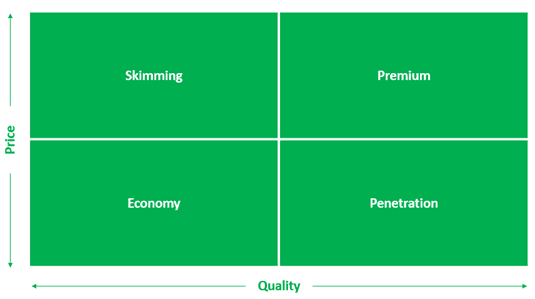Establishing proper pricing strategies is critical to business growth. Uninformed pricing leads to loss of profit margin and money left on the table. If you’re looking to start your strategic pricing journey, one of the best tools to use is the Pricing Strategy Matrix. The Pricing Strategy Matrix is a simple financial model with 4 prepopulated strategic pricing options representing combinations of price and quality:
Why focus on an offering’s price and quality? They are two of the most important factors customers evaluate when making a purchase decision. Below, we explore each of the four strategic pricing options to show how you can leverage market conditions and your offering’s value to optimize your price.
Before we dive in, it is important to note that the Pricing Strategy Matrix is extremely one-dimensional given the complex nature of markets, competitors, and customers. While the Price Matrix is a good place to kick off your strategic pricing journey, you do not want to fall into the trap of solely relying on 4 simple strategies.
Price Skimming
Price skimming is used for high-price, low-value offerings. The goal of this strategy is to maximize revenue as much as possible from your core customers before lowering the price. The idea is that when your core market becomes saturated, a lower price is offered to the more cost-sensitive general market. This strategy is used frequently in product launches where novelty is a crucial driver for customers. Take the video game market. New games are released constantly at premium price points. As the novelty wears out, games are discounted to generate more sales.
Advantages of Price Skimming:
- Generates the highest revenue and margin per customer
- Ensures production costs are covered
- Higher prices can signal higher value
- Lowering prices should increase sales
- Allows you to target a wider market
Price Skimming Disadvantages:
- Competitors can quickly undercut your price
- Price focus means lower brand loyalty
- Success dependent on timing
- Initial customers feel might feel cheated
- Price level unsustainable in the long run due to low value
Penetration Pricing
Penetration pricing is the opposite of price skimming. Here, the goal is to set a low initial cost on a high-quality offering. This strategy is utilized by organizations who want to enter (or penetrate) new markets. An initial low price helps attract new sales and creates a large customer base. The hope is customers will switch to a cheaper but better alternative. Once a business has established its offerings in the market, prices can increase, or an alternate pricing strategy can be adopted. Penetration pricing is commonly used by TV networks to increase their subscriber base. Initial subscriptions are usually set at a low price and as the customer becomes accustomed to watching certain channels or shows, the subscription price increases.
Penetration Pricing Advantages:
- Fastest way to gain market share from competitors
- Effective for price-sensitive customers
- Achieve economies of scale quickly through high initial sales volumes
- Increase market awareness
Disadvantages of Penetration Pricing:
- Poor profit margins due to lower price
- Low price leads to perceptions of low brand value
- Hard to increase prices in the future
- Longer time to recoup initial costs
Economy Pricing
Economy pricing occurs when both product quality and price points are deemed low. The goal is to have the lowest price in the market – to undercut competitors and attract customers. Think of generic-brand tissues instead of Kleenex or cola instead of Coke. These generic goods have lower marketing or production costs compared to their name-brand counterparts, which allows them to sell at a discount.
Advantages of Economy Pricing:
- Causes problems for competitors who cannot match price
- Opportunity to upsell customers on higher priced items
- Attractive for price-conscious customers
- Easy to grow market share
Economy Pricing Disadvantages:
- Hard to maintain good margins given current inflationary period
- Requires high sales volume to be successful
- Race to the bottom between competitors
- No customer loyalty
Premium Pricing
Premium pricing is the opposite of economy pricing. Here, the offering price and quality are both high. As the name suggests, this strategy seeks to cultivate the perception of a premium value offering in the market. Luxury brands like Louis Vuitton or Rolex often leverage Premium Pricing to attract image-conscious customers.
Premium Pricing Advantages:
- Massive profit margins
- Enhances perceived value of the brand
- Higher customer satisfaction due to high perception of offerings
Disadvantages of Premium Pricing:
- High marketing & branding costs that are difficult to maintain
- Pressure to innovate to keep up quality
- Cheaper competitors can steal your market share
- Sales can underperform in economic downturns
Final Thoughts on the Price Matrix
While the Pricing Strategy Matrix is easy to understand and quick to use, it oversimplifies the complicated subject of pricing. The market is constantly changing and your pricing strategy should change with it. Staying with one pricing strategy or price point ensures a weak top and bottom line.
There is no single price strategy that guarantees the highest amount of profit for every industry. Because of this, it is important to understand the different aspects of optimizing price, so you can discern which factors affect your business the most.
At RML, our team of Revenue Management experts can help optimize your pricing strategy. Our consulting services transform data into customized pricing strategies ready to be put into action. Contact us today and get ahead of the competition.
ABOUT THE AUTHOR Avy Punwasee is a Partner at Revenue Management Labs. Revenue Management Labs help companies develop and execute practical solutions to maximize long-term revenue and profitability. Connect with Avy at apunwasee@revenueml.com





